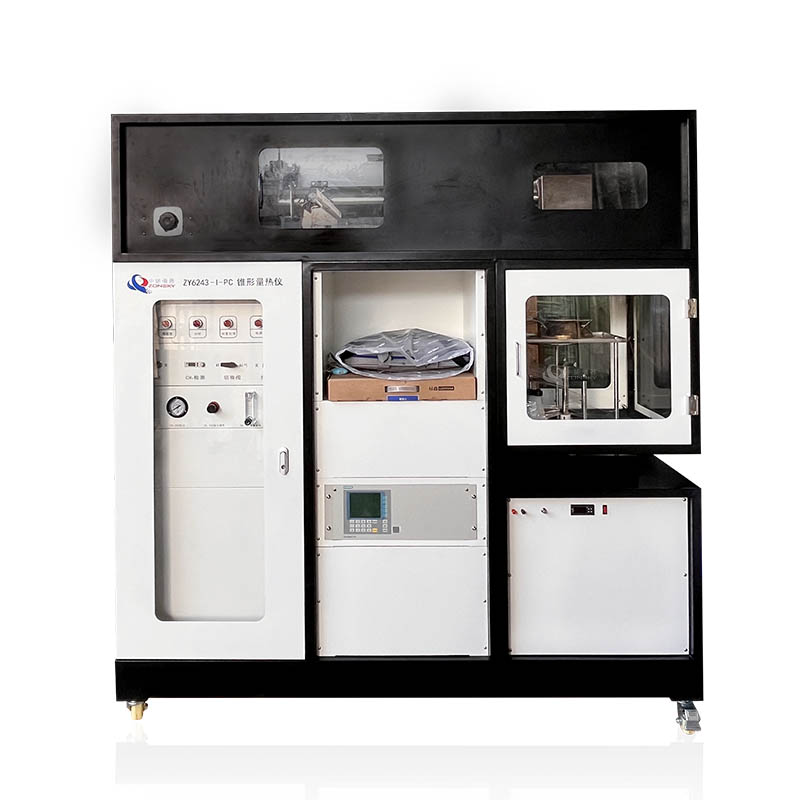
The oxygen consumption rate calculated from the oxygen concentration in the combustion product gas stream, as well as the heat release rate during combustion, are critical parameters for evaluating the combustion performance of materials. Accurately measuring the heat release rate during the combustion process is crucial for predicting fire hazards and for flame-retardant treatments. This process complies with the following test standards: ISO5660-1/-2, ASTM E1354, ASTM E1740, ASTM E1550, ASTM D5485, ASTM D6113, NFPA 271, NFPA 264, CAN/ULC-S135, and BS 476.
The oxygen consumption rate calculated from the oxygen concentration in the combustion product gas stream, as well as the heat release rate during combustion, are critical parameters for evaluating the combustion performance of materials. Accurately measuring the heat release rate during the combustion process is crucial for predicting fire hazards and for flame-retardant treatments.
Compliance:ISO5660-1/-2, ASTM E1354, ASTM E1740, ASTM E1550, ASTM D5485, ASTM D6113, NFPA 271, NFPA 264, CAN/ULC-S135, and BS 476.
.
1.Test Chamber:An enclosed space used to accommodate materials and experimental devices to be tested. Test chambers typically have controlled temperature, oxygen concentration, and ventilation rates to simulate different fire conditions.
2.Cone Heater:A specially designed heat source, usually consisting of a standardized combustion cone, used to apply heat to the surface of the material to be tested.
3.Gas Analysis System:used to monitor and record the composition of flue gases produced during the combustion process, including carbon monoxide, carbon dioxide, oxygen and other harmful gases.
4.Heat Release Rate Measurement System (HRR): used to monitor and record the heat released during the combustion process of materials in real time
1.Preparation: Place the material to be tested on the sample stage in the testing chamber and position the cone burner on the surface of the material.
2.Ignition:Start the cone burner to ignite the material to be tested. During the combustion process, parameters such as heat release rate and smoke production rate will be monitored and recorded.
3.Data collection: Use a gas analysis system and a heat release rate measurement system to collect and analyze data during the experiment.
Peak Heat Release Rate (PHRR): The maximum heat release rate generated during the combustion process, which reflects the burning ability of the material.
Smoke Production Rate (SPR): The rate of smoke generated during the combustion process, which is of great significance for assessing fire spread and safe evacuation.
Smoke Toxicity:The content and toxicity of harmful substances in smoke produced by combustion have an important impact on personnel safety.
1.1 Comply with GB/T16172-2007 "Test Method for Heat Release Rate of Building Materials".
1.2 Comply with current domestic and foreign test standards such as ISO 5660-1:2002 and ASTM E1354.
2.1 Radiation cone power: rated power 5000W. It can provide radiation intensity up to 100kw/㎡ on the sample surface, equipped with three thermocouples to measure temperature.
2.2 Radiation cone structure: The electric heating tube is tightly wound into a truncated cone shape and assembled in a double-layer heat-resistant conical sleeve. The inner and outer cone shells are filled with heat-resistant fibers with a nominal thickness of 13mm and a nominal density of 100kg/m³. The radiation intensity is uniform and corresponds to the radiation at the center, and the deviation does not exceed ±2%; the incident heat flow intensity of the conical heater can be selected according to different test requirements.
2.3 Sample mounting frame: It is a square open plate, the upper opening is: (106±1)mm×(106±1)mm, the depth is (25±1)mm, and the thickness of the mounting frame is 50 (2.4±0.15)mm stainless steel plate. It includes a handle for easy insertion and removal, and a mechanism to ensure that the center of the specimen is below the heater and accurately centered with the weighing device. A layer of low-density (nominal thickness 65kg/m3) heat-resistant fiber mat with a thickness of 13mm is placed at the bottom of the mounting frame; the distance between the lower surface of the radiation cone and the top of the sample is adjusted to (25±1) mm, for unstable size material, the distance from the lower surface of the radiation cone is (60 ± 1) mm.
2.4 Positioning frame: a square box made of stainless steel with a thickness of (1.9±0.1)mm, the inner dimension of the square box is (111±1)mm, and the height is (54±1)mm; it is used for the opening of the sample surface is (94.0±0.5)mm×(94.0±0.5)mm.
 WhatsApp:
WhatsApp: Mobile Phone:
Mobile Phone: Contact Now
Contact Now